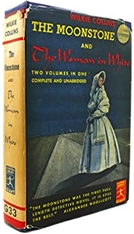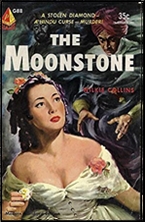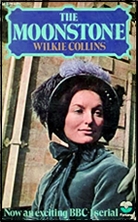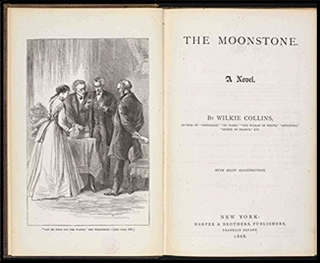Sun 21 Mar 2021
A 1001 Midnights Review: WILKIE COLLINS – The Moonstone.
Posted by Steve under 1001 Midnights , Reviews[7] Comments
by Marcia Muller

WILKIE COLLINS – The Moonstone. Tinsley, US, hardcover, 1868. Harper, US, hardcover 1868. Serialised in Charles Dickens’s magazine All the Year Round and in the US in Harper’s Weekly, circa 1868. Reprinted many times in both hardcover and soft. (The book has probably never been out of print.) Adapted many times for the stage, movies, radio, TV, comic books and (!) a podcast.
(William) Wilkie Collins was one of the most popular and accomplished writers of the nineteenth century, and The Moonstone is an early classic of the suspense genre. Like Collins’ other criminous works, it contains elements that later became staples of mystery writing: a purloined gemstone, carefully secreted clues, obtrusive red herrings, sinister Indians who lurk threateningly in the background, a blighted love affair, several shakily constructed alibis, numerous cliff-hanging scenes, and a mysterious suicide. Although complicated, the plot is well constructed and the reader’s interest seldom flags.

The yellow diamond known as the “moonstone” was stolen from an Indian religious idol by John Herncastle, a man who chose to ignore the story of bad luck following the diamond should it be removed from the possession of the worshipers of the moon god. Upon Herncastle’s death, the gem was willed to his niece, Rachel Verinder, and the young lady is about to receive it when the story opens (after a prologue and two tiresome chapters filled with background material).
The diamond disappears, of course, on the night Rachel is presented it by solicitor Franklin Blake. And when Inspector Cuff of Scotland Yard appears on the scene, some clues point to Blake, while others indicate Rachel has secreted away her own diamond for some unknown and possibly unbalanced reason.

The story proceeds, divided into two periods, respectively titled “The Loss of the Diamond” and “The Discovery of the Truth” (which in itself is divided into eight narratives), plus an epilogue. In spite of these numerous sections, each broken into various chapters narrated by different characters, the reader finds himself as determined as Cuff to learn the truth. Who are the Indians? Was this caused by the curse of the moonstone? Will Rachel find happiness? Such questions are ever in the forefront. And when the end is finally reached, all clues are tied up, all questions are answered, and — yes — Rachel does find happiness.
Collins’ other works are not nearly as well known as The Moonstone, but a number are just as engrossing and stand the test of time equally well. These include The Woman in White (1860), which seems to have been Collins’ personal favorite; and The Queen of Hearts (1859), a collection that contains the cornerstone humorous detective story “The Biter Bit.”
———
Reprinted with permission from 1001 Midnights, edited by Bill Pronzini & Marcia Muller and published by The Battered Silicon Dispatch Box, 2007. Copyright © 1986, 2007 by the Pronzini-Muller Family Trust.

March 21st, 2021 at 8:19 pm
Conan Doyle was so influenced he borrowed elements from it a few times, most notably The Sign of the Four.
Will Cuppy reviewed mysteries as Sgt. Cuff for years.
It remains a remarkably good read even today. Collins often stands in the shadow of his friend Dickens, but his work is fully as readable considering how distant these works are from us in time.
You can argue the import of Poe and Hoffman, but the mystery novel as we know it was invented by Collins.
March 21st, 2021 at 9:10 pm
I have not read this one since I was 12. It is time to read it again. Unfortunately between the time when I was 12 and now, there have been — how many books? — that I have not read the first time. It is a dilemma.
When, David, you say “… the mystery novel as we know it was invented by Collins,” echoing Marcia Muller’s review, you speak the truth.
March 21st, 2021 at 9:23 pm
I have two copies of The Moonstone here, one truncated or abridged, and the other as Collins intended. Claude took several English Lit courses at a variety of schools the most important of which from this aspect was the University of Toronto. She encouraged me to read Wilkie and later Trollope. Both were of interest.
March 21st, 2021 at 9:43 pm
The edition of THE MOONSTONE that I read was the Pyramid paperback which is the second image down. I can’t tell you know if it was abridged or not, but I suspect it was.
At age 12, I don’t think I would have cared if it was, and maybe rightly so. As I recall it’s a fairly long book.
March 21st, 2021 at 10:00 pm
The coda at the end of MOONSTONE still haunts me.
March 22nd, 2021 at 12:49 am
No praise is too much for this wonderful book. I myself, found relish in all the expository chapters, backstories, and character-building; I was charmed by the wonderful character ‘Betteredge’, the household’s head servant. Via that warm-hearted “gentleman’s gentleman”, we enjoy a gorgeously detailed look at a different world. It’s rather astounding how ‘modern-sounding’ the voices are in this and other great epistolary works of the era. Plunging into this immersive novel is an invigorating journey; I envy the reader who comes to it fresh. Long time since I myself had a treat of that caliber.
March 22nd, 2021 at 5:00 pm
I’ve only ever heard one criticism of the yarn which I’m forced to agree with: the pinion upon which the whole story rests is a bit of a stretch. Made worse because its a bit of story-taffy which has been stretched –in succeeding decades –far too often since. It is to Collins’ credit that he writes this underlying mechanism so sprightly and fresh-seeming; but if one wants to be harsh? Yea, we could probably all admit that it is as hoary and crusty as story-spinning gets. [Going out of my way here not to name it aloud so as not to spoil the story for anyone.]